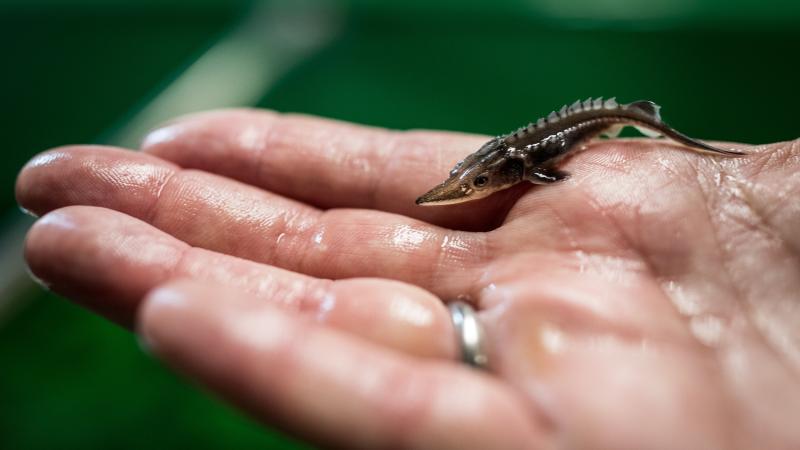
For the success of conservation programs such as the fish stock, everyone has to lend a hand: students send the sturgeon on the journey, so that in 10-20 years he will return to care for offspring. | Photo: Winfried Mausolf, Frankfurt (Oder)
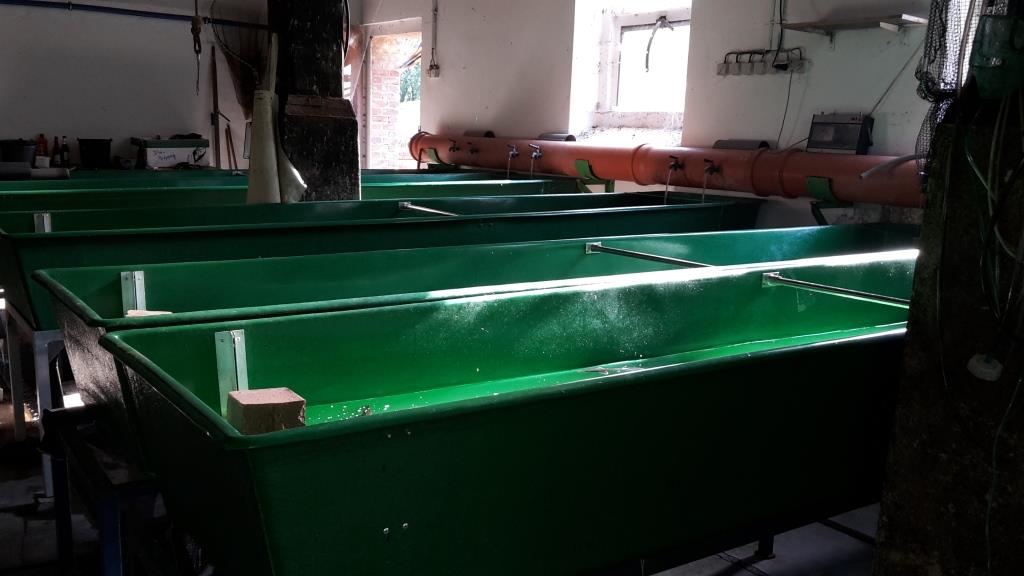 Breeding basin for young sturgeons
Breeding basin for young sturgeons
What does fish stocking mean?
The introduction of fish into waters in which they naturally live, or they have lived previously, is called ‘stocking’ or re-stocking respectively. In Germany, stocking is carried out with native fish species – these include carp, trout, pike, pikeperch, the European eel, the European and Baltic sturgeons, and many more. It is only when stocking species of non-native origin that you need permission from the regional fisheries authority.
Fish can be stocked at all developmental stages and they originate either from another water body or are reared in captivity. In the latter case, parents are required for breeding, and to provide viable offspring. The young fish subsequently are grown until they reach the desired size for stocking. The conditions of rearing vary largely from recirculating systems to open ponds depending upon species and purpose. In the case of the restoration of natural populations, it is attempted to adapt the fish to their natural habitat, water from the future habitat is used and the rearing environment is enriched. Resultingly, the young fish are already accustomed to the smell of their environment and enemies, and are thus able to recognise them when they experience these for real.
Nevertheless, the longer the fish are reared in a controlled environment, the more they adapt to these circumstances, they lose the ability to find food or to sense and avoid danger in a natural environment. However, the advantage of the stocking of older fish is that they are less susceptible to predators due to their larger size. These risks and advantages have to be considered specifically for each species to determine optimal stocking strategies. Data on the survival of stocked fish help scientists to find out whether larvae, which are only a few weeks old, or juveniles at an advanced stage to protect them from predators cope better with their new environment.
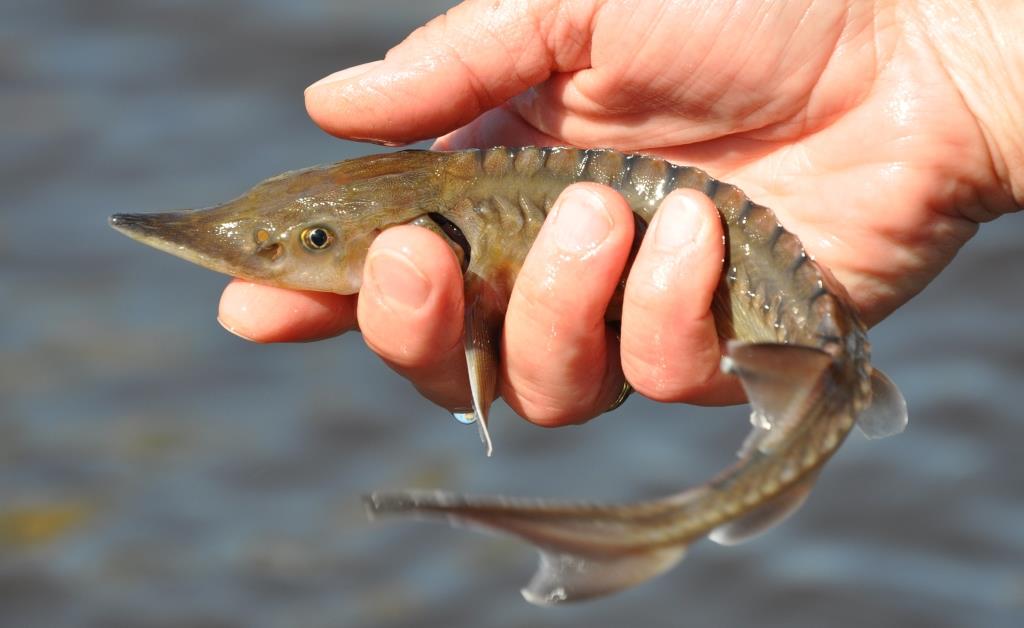
Sturgeon with marking number | Photo: C. Pusch
Why are fish stocked?
Many fish populations today are under threat by various environmental influences such as habitat destruction, water pollution, canalisation or overharvest. To protect these populations from extinction or even to maintain them at harvestable levels, anglers and fisheries associations are ensuring that fish are kept, reproduced and reared under controlled conditions to be released later on. The goal is to build up a stable population of fish which will be able to sustain itself in the future. This approach also is applied to facilitate the return of the sturgeon. A group of species which today is extinct in Germany. Until now, around 2 million sturgeons have already been released into native waters. There are currently reports of sturgeons, which have made it to Denmark and Sweden on their migration. All that remains now is to hope that they return to our rivers in ten to twenty years to reproduce themselves and to start a new native population.
As mentioned briefly, long-term protection of endangered fish species is not the only reason for stocking. Many anglers and fishers have more of a short-term goal in mind: releasing fish in order to be able to increase the number of their catch. This is the case, for example, with carp, who only reproduce in fish farms because the temperatures in open waters are too low for propagation. Population recovery through stocking is futile for such fish, but in spite of this, many carps are stocked in open waters every year.
In cooperation with anglers and fisheries associations, scientists are currently working on a solution which will combine both approaches. The goal is, that stocking will lead to a recovery of fish stocks and, in conjunction with habitat improvements and sound harvest regulations, contribute greatly to the protection of the species. It is only when these fish once again thrive in our lakes and rivers that fishers and anglers can catch more fish. Until then, the fishing of highly endangered species such as sturgeon must remain prohibited.
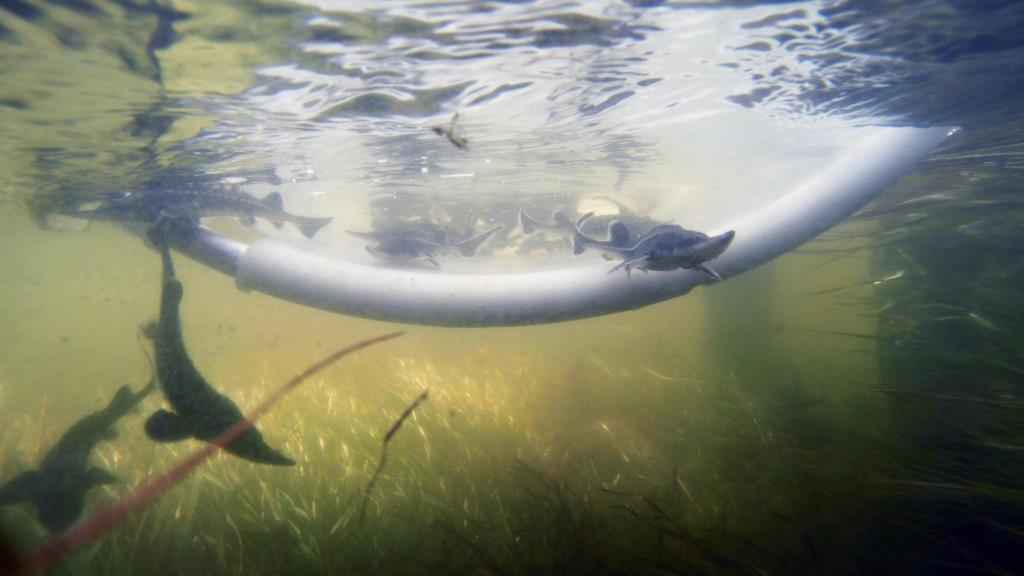
Stocking of Baltic young sturgeon | Photo: J. Gustafsson
Is stocking the only solution?
The causes that threaten various species of fish are diverse and have major implications on how they can be protected. In places where the continued existence of a species is threatened due to low numbers of breeding pairs, humans can increase the population through targeted stocking.
However, fish populations are also often threatened by the destruction of their habitat through construction of infrastructure and pollution or are impacted by industrial fishing. In such cases, stocking alone is not the solution!
An example for this interaction of impacts is the pike. Pikes settle in bodies of water with dense vegetation that protects the juveniles from other predatory fish. As the majority of native water bodies have been altered substantially, they offer little cover for young pike, limiting the carrying capacity. In such a case, stocking with juveniles would be pointless as long as their habitats remain to be restored. It is a similar case for migratory fish such as sturgeon, who spend their lives in various bodies of water, and are thus dependent on the function of diverse habitats as well as on the ability to move between them
For this reason, researchers have to assess the future habitats for the fish as well as other adverse impacts long before the fish are even released.
However, problems with the suitability of a water body of are often noticed only during the course of stocking operations and their subsequent monitoring. In these cases measures to improve the habitat quality have to be take place on top of the stocking.
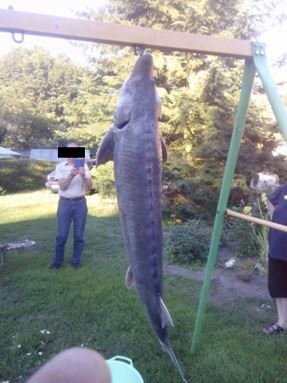
Illegal catch of a Baltic Sea sturgeon
If measures are carried out for the restoration of bodies of water, there is hope that this will lead to a recovery of the fish population. However, to predict the chances of success, the interactions of stocked fish and their habitats have to be understood. The survival of the fish is dependent on whether they are able to resist diseases and whether they are in the position to compete for food and avoid predators. On the other hand, legal as well as illegal fishing can be critical in preventing fish stocks from recovery despite of optimal conditions. Anglers and fishers should thus inform themselves of whether the animal at the end of their fishing line is a protected species and, as in the case of the sturgeon, may not be removed from the water – regardless of what condition it is in!

